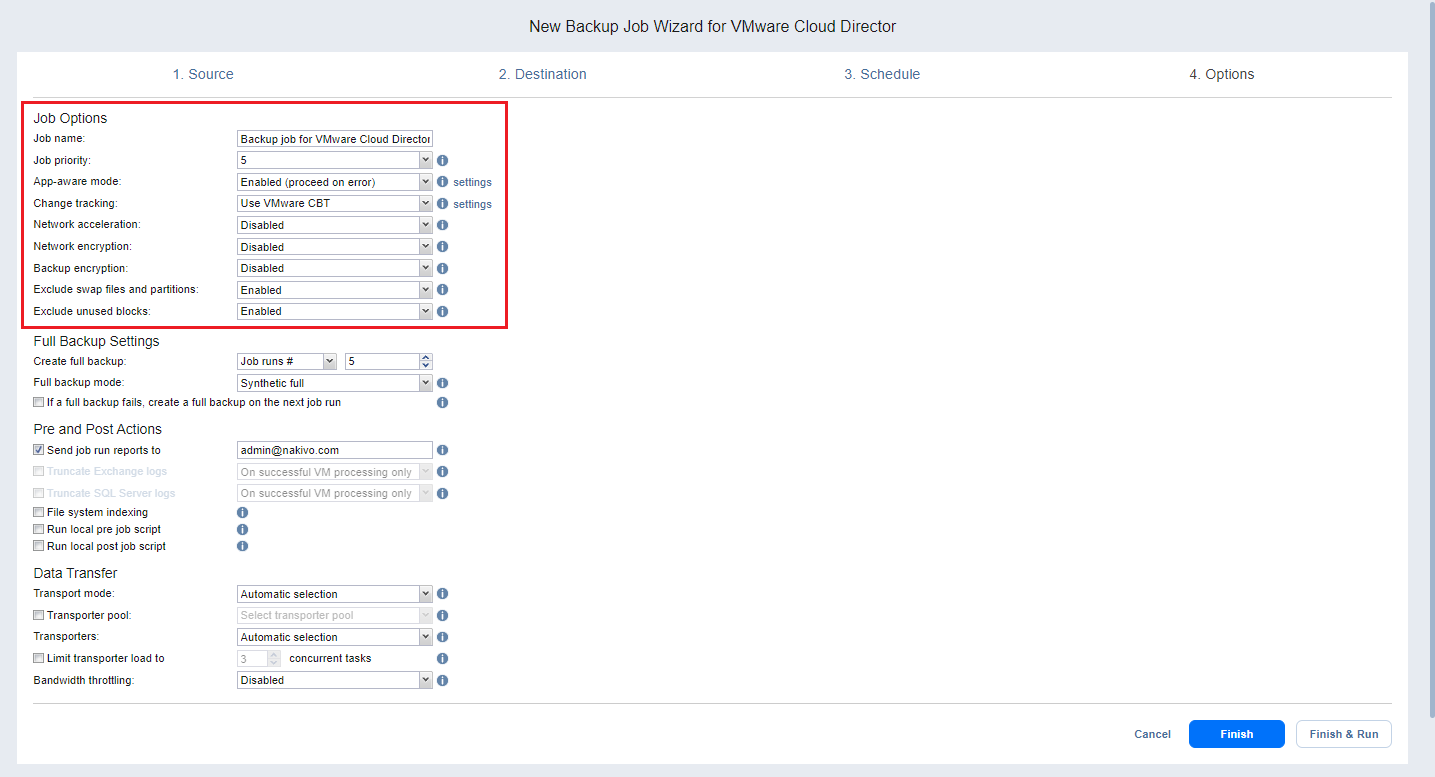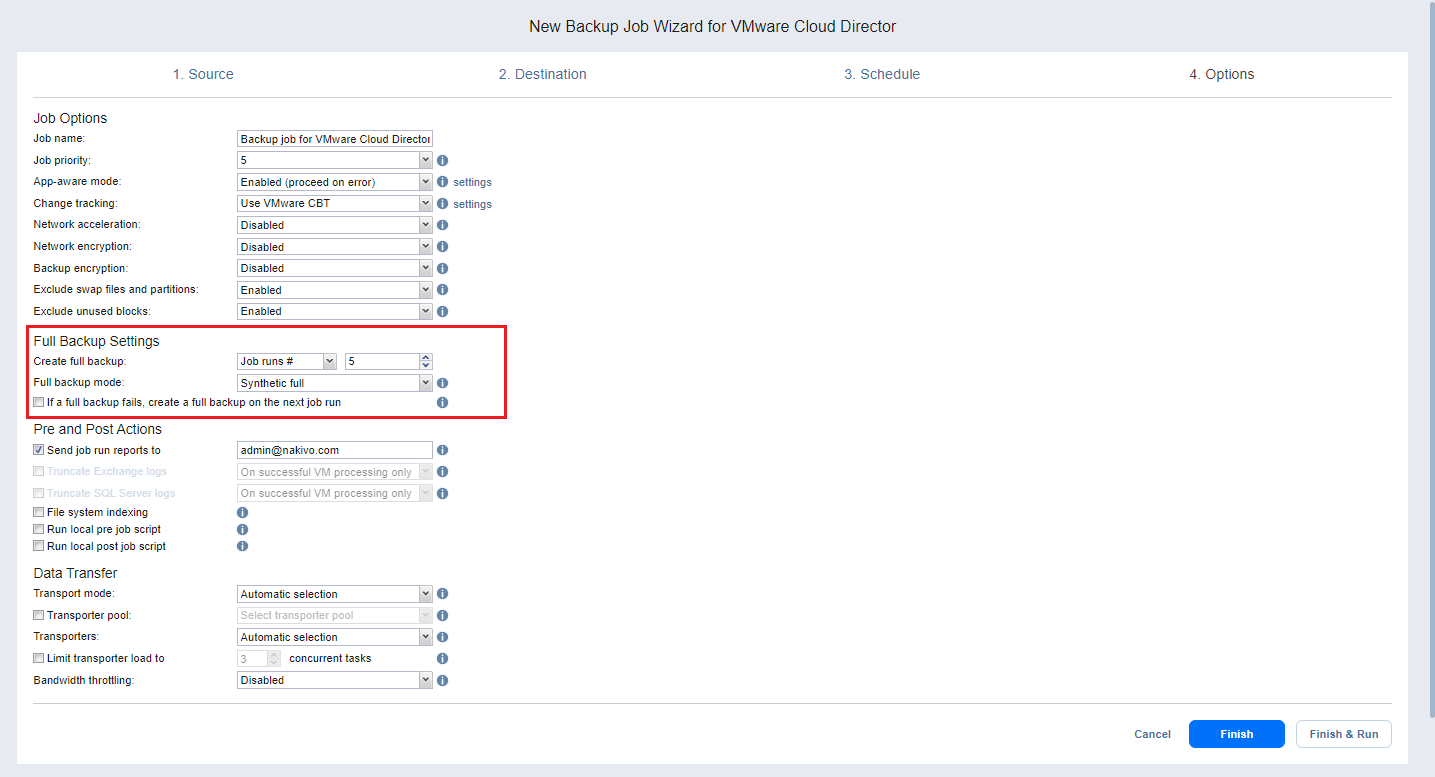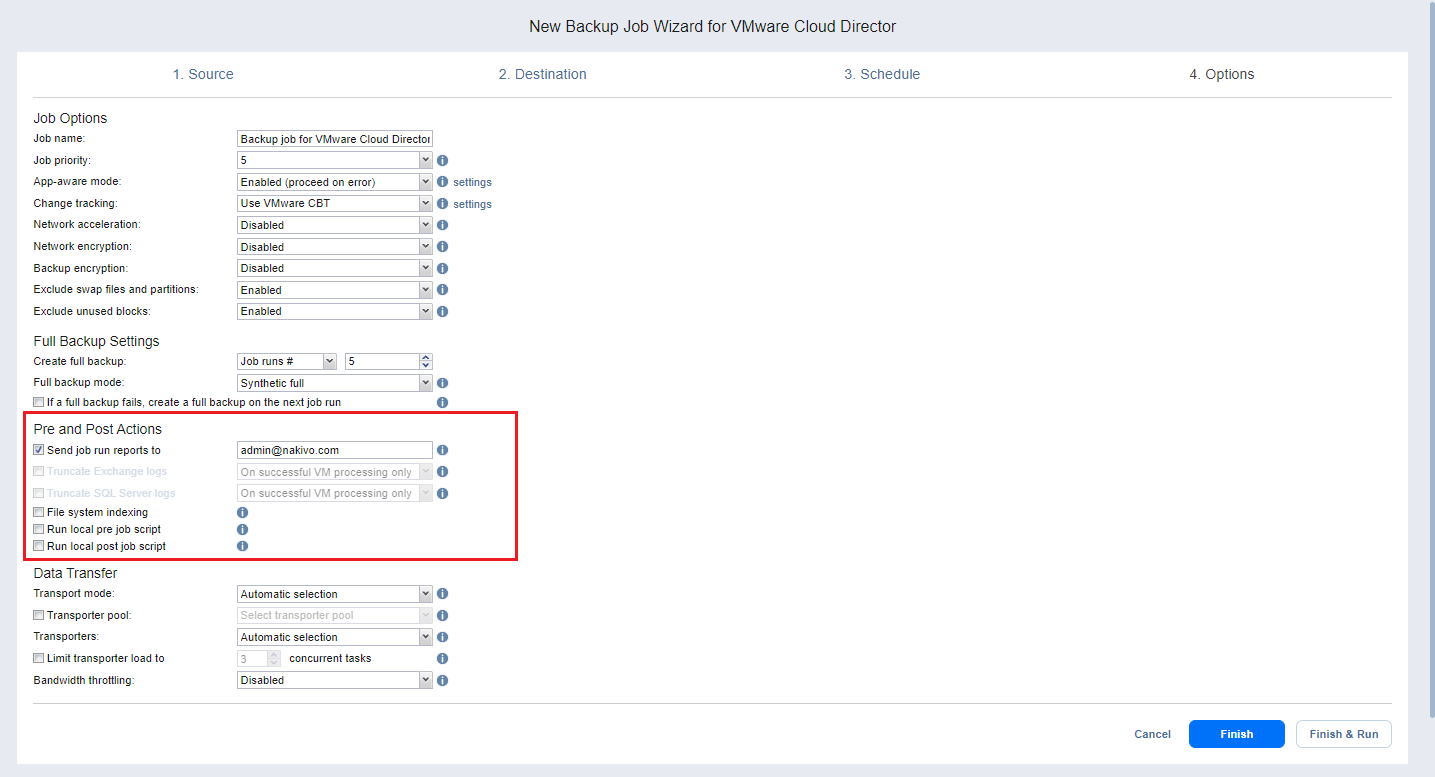Backup Job Wizard for VMware Cloud Director: Options
On the Options page of the wizard, you can set up various job options. Proceed as described in the sections below:
Job Options
In this section, you can specify a name for the backup job and enable/disable app-aware mode, change tracking, network acceleration, encryption, VM Verification, and other job options. Proceed as described below.
Job Name
Enter a name for the backup job in the appropriate box.
Job Priority
Select a job priority level between 1 and 5, with 1 being the highest priority. Jobs with higher priority levels are prioritized by Transporters during job processing.
Note
This option is only available in the Enterprise, Enterprise Essentials, Enterprise Plus, MSP Enterprise, and MSP Enterprise Plus editions.
App-Aware Mode
When the app-aware mode option is enabled, object backup is performed using VMware Guest OS quiescing which relies on Microsoft VSS to ensure that application data is consistent. For details, refer to Application and Database Support.
Change Tracking
Select one of the options from the Change tracking drop-down list:
-
Use VMware CBT: When selected, NAKIVO Backup & Replication enables the VMware Changed Block Tracking feature for source VMs. This feature enables the product to quickly identify the data blocks that have changed since the last job run, which significantly speeds up the job. Click the error handling link to specify how errors should be handled.
On error: Choose one of the following job behaviors in relation to CBT error:-
switch to proprietary method: If VMware CBT fails to provide data on changed blocks for a VM and this option is selected, NAKIVO Backup & Replication performs an incremental backup of the VM using the NAKIVO proprietary change tracking technology.
-
reset CBT: If VMware CBT fails to provide data on changed blocks for a VM and this option is selected, NAKIVO Backup & Replication resets VMware CBT for the VM.
-
fail VM processing: If VMware CBT fails to provide data on changed blocks for a VM and this option is selected, NAKIVO Backup & Replication does not process the VM and states job failure (other VMs in the job will be processed).
-
-
Double-check changed blocks provided by CBT: When selected, NAKIVO Backup & Replication runs a check on data blocks provided by VMware CBT to ensure that VMware CBT does not overstate the amount of changed data.
-
Use proprietary method: When selected, NAKIVO Backup & Replication performs incremental backups using the NAKIVO proprietary change tracking technology. This feature requires reading the contents of all VM disks to determine which data blocks have changed since the last job run.
-
No change tracking (always full): When selected, NAKIVO Backup & Replication always performs a full VM backup of all source VMs.
Network Acceleration
When enabled, NAKIVO Backup & Replication uses compression and traffic reduction techniques to speed up data transfers. Select this option when you back up over WAN or slow LAN links. For more information about this feature, refer to Network Acceleration.
Note
The Network acceleration option is not available if the Backup encryption option is enabled.
Network Encryption
With the Network Encryption option enabled, VM data is protected with AES 256 encryption while traveling over the network. Data encryption increases the backup time and CPU load on machines running Transporters. Select this option if you are planning to back up over WAN without a VPN connection.
You need at least one Transporter at source and target sites to enable network encryption.
Backup Encryption
When enabled, backup data is protected with AES 256 block cipher encryption with a 256-bit key length. You can protect the backup file by creating a new password or selecting an existing one. For more information, refer to Enabling Backup Encryption.
Notes
This option is available only if the Disk or Tape destination type was chosen on the Destination page of the wizard.
The Backup encryption option is not available if the Network acceleration option is enabled.
If enabled, the created recovery points are encrypted.
The Backup encryption option is not displayed for a backup job where forever incremental repositories are selected as the only target repositories.
The Backup encryption option cannot be enabled if multiple targets with a mix of supported and unsupported (SaaS repositories or forever incremental repositories) repositories are selected as destinations.
It’s recommended that you enable the (AWS) Key Management Service. If KMS is enabled, all backup encryption passwords encrypted with the Key Management Service cryptographic key are available for recovery in case of product re-installation. For more information, refer to Enabling KMS.
Exclude Swap Files and Partitions
With this option enabled, NAKIVO Backup & Replication automatically excludes swap files and partitions during the backup process. For more information about the feature, refer to Excluding Swap Files and Partitions.
Exclude Unused Blocks
With this option enabled, NAKIVO Backup & Replication automatically excludes unused disk blocks and blocks occupied by deleted files during processing of source objects running Windows OS. This feature allows you to reduce backup storage space and object processing time. For more information, refer to Excluding Unused Blocks.
Full Backup Settings
When you set the type of Backup Repository on the Destination page of the wizard to Incremental with full backups (Store backups in separate files option is selected), you can specify the following options:
-
Create full backup: Specify how often full backups should be created.
-
Full backup mode: Specify how the full backup should be created. You can choose one of the following options:
-
Synthetic Full: When this option is selected, NAKIVO Backup & Replication first performs an incremental backup (that is, transfers only the data that has changed since the last backup) and then transforms the available data into a full backup file. The benefits of this approach are:
-
The Synthetic Full backup is usually faster than the Active Full backup.
-
The load on the network is lower as less data is transferred.
-
The load on the source datastores running your production VMs is lower.
-
-
Active Full: When this option is selected, NAKIVO Backup & Replication reads all VM data from the source datastore and transfers the data to the Backup Repository.
-
-
If a full backup fails, create a full backup on the next job run: With this option selected, the next job run creates a full backup if the current job run fails to do so.
Pre and Post Job Actions
NAKIVO Backup & Replication allows you to enable certain actions before a backup job begins and after it has completed. You can choose to send job run reports, truncate Microsoft Exchange and Microsoft SQL Server logs on specific VMs, and run local pre- and post- job scripts.
Email Notifications
NAKIVO Backup & Replication can send email notifications about job completion status to specified recipients. This feature complements global notifications and allows you to configure notifications on a per-job level.
To enable this option, configure your Email settings. Refer to Email Settings.
To send email notifications, select Send job run reports to and specify one or more email addresses in the text box. Use semicolons to separate multiple email addresses.
Truncation of Microsoft Exchange Transaction Logs
Microsoft Exchange Server database transaction logs record all changes to an Exchange Server database. Over time, these log files accumulate and can consume all of the available disk space if not periodically removed. NAKIVO Backup & Replication provides an option to delete (that is truncate) Microsoft Exchange Server logs on the source VMs after job completion.
The transaction logs are deleted after the job is completed so that the log files are available in the VM backup. Note that the product deletes only those transaction logs that are already committed to (available in) the Microsoft Exchange database.
To set up Microsoft Exchange log truncation, do the following:
-
Select the Truncate Exchange logs option.
-
In the dialog box that opens, select the checkboxes next to the VMs running Microsoft Exchange and then select the credentials next to each VM. These credentials will be used to log in to the VMs that you have selected.
Truncation of Microsoft SQL Server Transaction Logs
Microsoft SQL Server database transaction logs record all changes to an SQL Server database. Over time, these logs accumulate and can consume all of the available disk space if not periodically removed. NAKIVO Backup & Replication provides the option to delete (that is truncate) Microsoft SQL Server logs on the source VMs after job completion.
The transaction logs are deleted after the job is completed so that the original log records are available in the VM backup. Note that the product deletes only those transaction logs that are already committed to (available in) the Microsoft SQL Server database.
To set up Microsoft SQL Server log truncation, do the following:
-
Select the Truncate SQL Server logs option.
-
In the dialog box that opens, select the checkboxes next to the VMs running Microsoft SQL Server and then select credentials next to each VM. These credentials will be used to log in to the VMs that you have selected
Pre Job Script
To run a script before NAKIVO Backup & Replication begins backing up objects, do the following:
-
Place a script file on the machine on which the Director is installed.
-
Select the Run local pre job script option.
-
Specify the following options in the dialog box that opens:
-
Script path: Specify a local path to the script on the machine on which the Director is installed. A script interpreter should be specified.
Example (Windows): cmd.exe /c D:\script.bat
Example (Linux): bash /root/script.sh -
Job behavior: Choose one of the following job behaviors in relation to script completion:
-
Wait for the script to finish: When this option is selected, object backup is only started after the script is completed.
-
Do not wait for the script to finish: When this option is selected, the product runs the script and starts backing up objects at the same time.
-
-
Error handling: Choose one of the following job behaviors in relation to script failure:
-
Continue the job on script failure: When this option is selected, the job performs object backup even if the script has failed.
-
Fail the job on script failure: When this option is selected and the script fails, the job is failed and object backup is not performed.
-
-
Post Job Script
To run a script after NAKIVO Backup & Replication has finished backing up all objects, do the following:
-
Place a script file on the machine on which the Director is installed.
-
Select the Run local post job script option.
-
Specify the following options in the dialog box that opens:
-
Script path: Specify a local path to the script on the machine on which the Director is installed. A script interpreter should be specified.
Example (Windows): cmd.exe /c D:\script.bat
Example (Linux): bash /root/script.sh -
Job behavior: Choose one of the following job behaviors in relation to script completion:
-
Wait for the script to finish: When this option is selected, the job is in the “running” state until the script is completed.
-
Do not wait for the script to finish: When this option is selected, the job is completed even if the script execution is still in progress.
-
-
Error handling: Choose one of the following job behaviors in relation to script failure:
-
Continue the job on script failure: When this option is selected, script failure does not affect the status of the job.
-
Fail the job on script failure: When this option is selected and the script fails, the job status is set to “failed” even if object backup is successful.
-
-
Important
Pre- and post-job scripts can be executed only on the machine on which the Director is installed.
Data Transfer
In the Data Transfer section of the Options page, you can choose the transport mode, select a Transporter to be used for reading data from source objects, specify the Transporter load, and configure bandwidth throttling.
Transport Mode
To select a transport mode, do the following:
-
In the Data Transfer section, choose the transport mode for retrieving object data:
-
Automatic selection: When this option is selected, NAKIVO Backup & Replication automatically selects the best transport mode available:
-
When the source Transporter is installed on a VM, NAKIVO Backup & Replication tries to use transport modes in the following order: HotAdd > SAN > LAN.
-
When the source Transporter is installed on a physical machine, NAKIVO Backup & Replication tries to use transport modes in the following order: SAN > LAN. HotAdd is not supported for physical machines.
-
-
SAN only: When this option is selected, NAKIVO Backup & Replication uses direct SAN access only to retrieve VM data. If direct SAN access to VM data is not available, the job fails.
-
Hot Add only: When this option is selected, NAKIVO Backup & Replication uses HotAdd only to retrieve VM data. If direct HotAdd is not available, the job fails.
Note
When HotAdd cannot be enabled for at least one disk of a source VM (even if the disk is deselected in the job), HotAdd is unavailable for all disks of the VM. -
LAN only: When this option is selected, NAKIVO Backup & Replication retrieves VM data over LAN only.
-
Transporter Pool
If this option is enabled, only the transporters that belong to the selected transporter pool shall be used during the job run.
Transporters
In NAKIVO Backup & Replication, Transporters perform all of the heavy lifting: reading data from the source object, compressing the data, transferring the data over the network, performing data deduplication, and so on. In large and geographically distributed environments, multiple Transporters can be deployed to distribute the data protection workload, optimize network traffic, and improve data transfer speeds. When more than one Transporter is deployed for NAKIVO Backup & Replication, it is important to determine which of these Transporters should be used to read data from a particular source VM (the target Transporter is always the one that is assigned to the Backup Repository).
By default, the product automatically determines which Transporter should be used to read data from the source VM. However, you can manually specify which Transporters should be used for the job. To manually specify Transporters, proceed as follows:
In the Data Transfer section, choose one of the following options:
-
Automatic selection: The product automatically determines which Transporters are the closest to source hosts (the hosts that run selected VMs) and uses those Transporters to retrieve data from source VMs.
-
Manual - configured for all VMs: Select this option to manually specify a single Transporter to be used to retrieve data from source VMs.
-
Manual - configured per host: Select this option to manually specify which Transporter should be used to retrieve data from each source host.
Note
The target Transporter for the backup job will always be the Transporter assigned to the Backup Repository.
Replacement Transporters
When configuring NAKIVO Backup & Replication, you can manually select a primary and replacement Transporter for each separate host or set them to be selected automatically.
Note
This option becomes available only if you select Manual - configured per host from the Transporters drop-down list.
You have the following options:
-
Select automatically: When selected, the replacement Transporters are selected automatically for each host.
-
Select manually per host: When selected, the Transporters can be selected manually or can be set to be chosen automatically for each separate host.
-
Use primary transporters only: When selected, only primary Transporters are used during job execution.
Transporter Load
You can limit the maximum number of Transporter tasks assigned to the job. By default, this number is set to 3 concurrent tasks.
To change the default number of tasks, do the following:
-
In the Data Transfer section, select the Limit transporter load to checkbox.
-
Specify the number of concurrent tasks in the corresponding box.
Bandwidth Throttling
Follow the steps below to regulate the speed of data transfer over the network for your backup job:
-
For the Bandwidth throttling option, choose Enabled.
Note
If bandwidth throttling is disabled for the current job, global bandwidth rules may still apply to your job. Refer to Bandwidth Throttling for details. -
Click the settings link that becomes available.
-
The Job Bandwidth Rules dialog box opens, displaying the list of available rules. You have the following options:
-
Create a new bandwidth rule for your backup job:
-
Click the Create New Rule button.
-
The New Bandwidth Rule dialog box opens. Refer to the Bandwidth Throttling topic for details on creating a bandwidth rule.
-
Click Save.
-
-
Activate an existing bandwidth rule for your job. Select the checkbox to the left of the required bandwidth rule. To deactivate a bandwidth rule for your job, deselect the corresponding checkbox.
-
Edit a bandwidth rule. Click the Edit link for a bandwidth rule and modify it in the Edit Bandwidth Rule dialog box that opens.
-
Disable a bandwidth rule. Click the Disable link. The bandwidth rule is disabled for all jobs.
-
Remove a bandwidth rule. Click the Remove link and then click Delete to confirm your operation.
-
Completing the New Backup Job Wizard for VMware Cloud Director
Click Finish or Finish & Run to complete job creation.
Note
If you click Finish & Run, you will have to define the scope of your job. Fore details, refer to Running Jobs on Demand.



